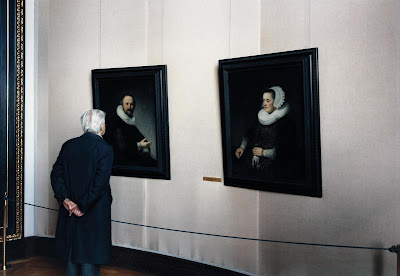This chapter focuses on Thomas Struth's 3 bodies of work entitled: Museum Photographs, Pergamon Museum I-VI and Audience. All three series is being photographed in museums or churches, to visually put these images into words would be to say Struth is engaging the idea of physical permeability of the picture plane. A collapse of space connects two separate worlds by means of the photograph. Each painting hung in these museums live in their own reality on a wall in a museum or church, yet, the photograph holds a moment in time when these figures were part of this, however this world depicted in the photograph is not our reality it only lives in the picture plane.
Kunsthistorisches Museum 3, Vienna
Map 1
For example one of Struth's pictures Kunsthistorisches Museum 3, Vienna (refer to image) shows a man who is looking at paintings of a married couple looking towards each other despite the frames that contain them. He is a older man with white hair and a blue sweater, grasping his hands behind his back while studying the paintings. Looking at this image you begin to be aware of this "imaginary moment" (refer to map 1). The woman in the painting looks as if she is staring right at the old man but if this photograph was taken at any other angle would the same effect happen? By assuming that the white haired man is not part of the conversation we realize that the collapse of space or the intersection of these two worlds connect painting and photography and creates a world we cannot identify with but resemble ours extremely closely. (refer to Art Institute of Chicago 2)
The Art Institute of Chicago 2
Map 2
Lee Friedlander "At Work"
Boston, Massachusetts, 1986
The second major intension of Struth's Museum Photographs was to catch a beholder transfixed and completely absorbed (and unaware of being beheld) to represent "a world of their own, a world in that respect-so to speak metaphorically-distinct and apart from that of the beholder" (Fried, 127). (refer to map 2) While most of his museum photographs fit this description, there are few that do not. Including, Rijksmuseum I, Amsterdam, 1990 where a young woman is sitting on a bench placed in front a painting, she sits towards the camera starring at us. Not absorbed and ultimately not as interesting as Struth's other work. Fried then asks the question of Lee Friedlander's series called "At Work" if they are truthful or just faking it for the camera? Significantly, no one has ever suggested that his subject weren't truthful (refer to image Boston, Massachusetts, 1986).
Pergamon Museum I
Map 3
I would like to agree with what Fried has said about Thomas Struth in regards to Riksmuseum I, because by making contact with the beholder we lose sense of a 3 dimension and all of a sudden it becomes too obvious. Struth as well realizes that he needs figures to respond to other figures not towards the camera. In his body called Pergamon I-VI, Struth actually went to the length of setting up a shot. (refer to Pergamon Museum I) In this image you see the artifacts that let you know that these are constructed and posed, which I find to be almost seamless except for the mistakes Fried points out (refer to map 3) what I understand is that the exposure was about 15 seconds so in order to get the shot he needed to have the people set up. But then how do we know that this wasn't what he was trying to convey, just this time his figures were deliberately performing absorption. There is a quote the Fried goes back to often, "There is an ineffable but fatal difference in attitude between people behaving naturally and people behaving naturally for a camera" (Fried, 137). To me that really sums up what you see, without knowing your are being photographed you allow a part of yourself to be captured that you weren't even aware you possessed but to know you will be photographed one usually gives away a part of themselves that they know well.
Audience 7
Audience 2
His earlier Museum Photographs differ quite a bit from the Audience series, just purely because of his presence as a photographer. Meaning to say that Struth quite literally stands in front of statues, paintings or in the midst of painted ceilings with bright lights and a big camera, attracting attention. This body feels a lot different then the earlier bodies, without a reference of what they are looking at except for small detail like the reflection in a pair of sunglasses (refer to Audience 7). These images feel more intimate then Museum Photographs or Pergamon Museum for the fact of our distance from the subject. (refer to Audience 2) I haven't had the pleasure of seeing this work before so I was please to see something new.

















